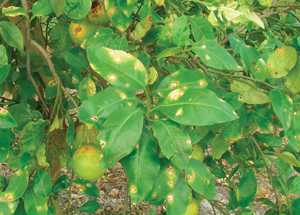Citrus Canker Confirmed For First Time In Florida Panhandle
 Citrus canker, a serious disease of citrus trees, was recently confirmed in southern Santa Rosa County in Northwest Florida. Despite its prevalence in South and Central Florida, this disease has not been known in the Panhandle until now. It is economically damaging to the commercial industry and problematic to homeowners because it causes premature fruit drop, discolored fruit, and eventually causes the tree to become unproductive.
Citrus canker, a serious disease of citrus trees, was recently confirmed in southern Santa Rosa County in Northwest Florida. Despite its prevalence in South and Central Florida, this disease has not been known in the Panhandle until now. It is economically damaging to the commercial industry and problematic to homeowners because it causes premature fruit drop, discolored fruit, and eventually causes the tree to become unproductive.
The University of Florida and the Florida Department of Agriculture and Consumer Services’ Division of Plant Industry will be assessing the extent of the disease in Santa Rosa County in the coming months.
Canker was first introduced in 1912 into Florida and was declared eradicated in 1933. The disease was found again in the Tampa area on citrus in 1986. It was declared eradicated in 1994, but once again was found in 1995 in Miami. This time, the disease was not successfully eradicated in part because hurricanes made the disease too widespread to control.
The disease is highly contagious to citrus only and spreads rapidly through wind, rain and via people on their hands, clothes and tools. The microscopic bacteria enter the leaves, fruit and twigs through natural pores for gas exchange and through any type of wound, including those from pruning and insect feeding damage. One of the most common types of insect damage on citrus is the leafminer.
Until now, horticulture Extension agents did not recommend using any control methods for leafminer as the damage was only considered to be cosmetic. The current recommendation is to apply a control for the leafminer when the tree has a flush of succulent new growth that is attractive to the adult leafminer. Controls for the homeowner include the use of horticultural oil and products containing spinosad as the active ingredient. Apply at the rate and intervals listed on the product label and target the flush of new leaves, making sure to coat the undersides of leaves where the adults generally lay their eggs. It is best to treat prior to visible damage to the new flush of growth.
The fruit can be protected from canker with copper sprays. Copper is the only registered product for the prevention of the disease. Please refer to the publication found here: http://edis.ifas.ufl.edu/pp116 for details on timing of sprays.
There is no mandatory removal of infected trees by the State of Florida. However, in areas such as the Panhandle where the disease has not been known to exist, tree removal or aggressive pruning of infected limbs should be considered to slow the spread of the canker to other citrus trees.
Source: UF/IFAS









